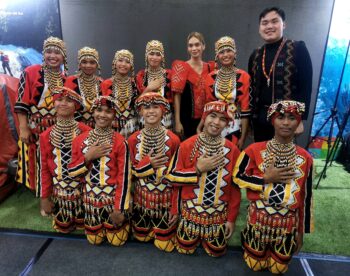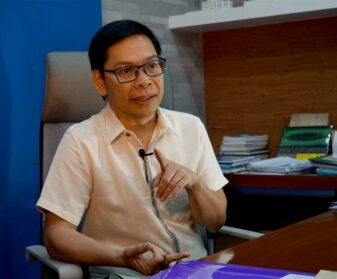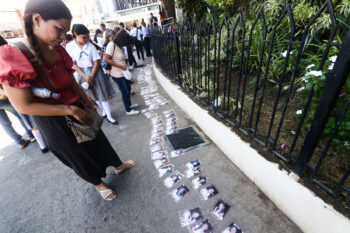BROOKLYN, New York (MindaNews/02 May) – Springtime seems to be the apt season to refer to New York City as the Big Apple for at this time, the city appears to be quite luscious. Late April and early May this year, I find myself in this city that never sleeps. Flowers of all colors and shapes – tulips, daffodils, violets, lilies, chrysanthemum and even wildflowers – bloom everywhere. And even as they are more associated with Kyoto and Washington D.C., the cherry blossoms in New York City can take the breath away.
Everyone who dreams of visiting New York City already knows the city’s moniker. From what can be googled, we are told that the nickname arose in the 1920s as a sports writer of the New York Morning Telegraph, John J. Fitz Gerald, began referring to this city as the big apple in a number of horse-racing articles. But naturally, there are a few more theories as to how the name arose. One of these provides a rather dramatic twist worthy of a Broadway play, namely that the “big apples” referred to the “girls of brothel madam” aptly named Eve. (This theory, however, has been debunked as a hoax!).
New York City is a nation in itself with a total population of 8.623 million as of 2017 and continuing to increase. While other global cities – from Hong Kong to London, Rio de Janeiro to Paris – show such a diverse population constituted by various races, religious traditions, regional accents, body shapes, genders and other categories, one can assume that New York City is the most differentiated. One only has to take a subway ride during peak hours to make this conclusion. As one maneuvers through a tight space in this flow of humanity moving like ants, one is mesmerized by the kaleidoscopic images of constantly changing patterns.
It is also a city that is defined by art manifested in the everyday, even as one knows that the height of artistic excellence thrives in this location whether in opera, symphony concerts, visual art and theatrical productions. While the latter can be had if one has deep pockets, the former, however, is free. The subterranean spaces of subway stations provide for free concerts, although has to contend with all kinds of noises that could drown the sound of music. One of the most impressive I have seen so far during this short visit here is the performance of a beautiful young girl with flowing white hair, playing some kind of a modern black violin with a very narrow shape, perhaps only one-fourth of the usual size of a violin. She was playing Bach soulfully and one notices that everyone who passes her space stops for a second to admire her performance.
But while the Big Apple is luscious, one imagines a worm wriggling itself through its flesh. One only has to listen intently to the voices that announce warnings while riding the subway. One is a warning that the New York Police can randomly stop anyone with a backpack and be subjected to inspection. Another insists that passengers who notice strange things inside or outside the trains should immediately notify a policeman or the train’s staff persons. Coming from Mindanao’s martial law with all its checkpoints and show of military/police power, the notices can cause a certain paranoia as to one’s safety. Then there are, of course, the street-people – beggars, vagabonds, mentally ill, the homeless – who are at the city’s margins and who desperately try to cope with the harsh life of urban living.
A big city as New York in these global times of terrorism when bombs can be planted anywhere and could blow up anytime, I can imagine the nightmares faced by the authorities in charge of the city’s security. No wonder all important spots in the city have people in uniform guarding the premises. Whether one goes to the Grand Central station or St. Patrick’s cathedral, your bags need to be randomly inspected and Big Brother’s eyes are constantly watching for possible disturbances. The feeling of being watched begins to surface as soon as the visitor arrives at the airport’s arrival hall, when all kinds of machines – more than human beings – subject the newly arrived person through all kinds of security checks.
Still, one can understand that most of the world’s citizens would dream of coming to New York at least once in their lifetime. It cannot be denied that through the centuries, this city has drawn the curiosity and interest of peoples all over the world. The energy generated by everything that happens here by everyone who constitutes the city’s populace through time is intoxicating. One only has to walk through the canyons of the skyscrapers, stand still in the midst of all the lights of Broadway, gaze across the ocean to the Statue of Liberty, and join the thousands who remember what happened at the spot where now stands the 9/11 Memorial to dig deep into the soul of this city.
Lucky are we who get a chance to visit this grand city and somehow survive comfortably through the generosity of our hosts. And for those coming from tropical countries, one is lucky to be here in springtime when the cold no longer penetrates the bones and the colors are quite magical. But still, lucky are we if after a short visit to the big apple, we can go home and be able to eat durian, rambutan, mangosteen and all the fruits that grow in our backyards!
[Redemptorist Brother Karl Gaspar is Academic Dean of the Redemptorists’ St. Alphonsus Theological and Mission Institute (SATMI) in Davao City and a professor of Anthropology at the Ateneo de Davao University. Gaspar is author of several books, including “Desperately Seeking God’s Saving Action: Yolanda Survivors’ Hope Beyond Heartbreaking Lamentations” and two books on Davao history launched in December 2015. He writes two columns for MindaNews, one in English (A Sojourner’s Views) and the other in Binisaya (Panaw-Lantaw).]







